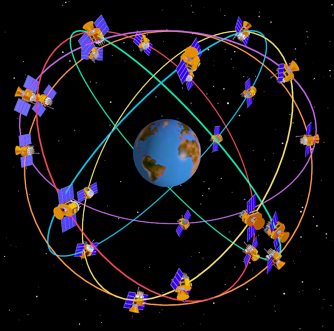|
|
|
|
5. Satellite-based positioning - A) Segments
|
|
|
The basic constellation, or building bricks
of GPS:
-
Space segment:
the satellites that orbit the Earth, and the radio signals
that they emit.
- Control segment: the ground
stations that monitor and maintain the space segment components.
- User segment: the users with
their hard- and software to conduct positioning.
The space
segment of GPS consists of 24 satellites on 6 orbits
(approx. 22,000 km from the centre of the Earth):
-
Each satellite carries
a clock
-
Each satellite completes
2 orbits/day.
-
24 hour complete
GPS coverage anywhere on the Earth.
-
Accuracy: 21 meters
95% of time
-
a master control station
(MCS),
-
an alternate master control
station,
-
four dedicated ground antennas
and
-
six dedicated monitor
stations

Ad 3) User segment
The user
segment is composed of hundreds of thousands of U.S. and
allied military users of the secure GPS Precise Positioning
Service, and tens of millions of civil, commercial and scientific
users of the Standard Positioning Service.
In general, GPS receivers are composed
of an antenna, tuned to the frequencies transmitted
by the satellites, receiver-processors, and
a highly stable clock (often a crystal
oscillator).

How to select a GPS receiver?
- Application (boating, flying, driving,
mapping, surveying)
- Accuracy requirements
- Power consumption requirements
- Operational environment
- Signal processing requirements
- Cost
- Data exchange standard
|
  |
|
|
|
|
|
|
|


